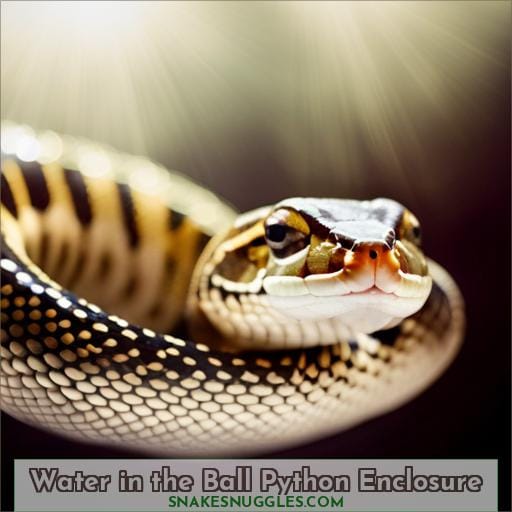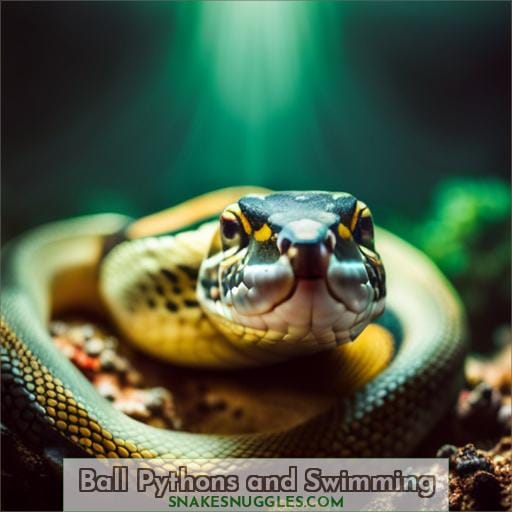This site is supported by our readers. We may earn a commission, at no cost to you, if you purchase through links.

Let’s first explore where these reptiles come from and how much swimming, if any, should be allowed. Ball pythons are native to sub-Saharan Africa, an area known for its grasslands and savannas with plenty of places for snakes—and other animals—to hide from predators.
They love burrowing into crevices such as those found among large rocks or rotting logs within forests and farms alike. However, being cold-blooded creatures means they also need access to water sources like ponds or streams when temperatures rise too high during summer months, which helps them stay cool.
So yes – ball pythons can indeed swim at times!
Table Of Contents
Key Takeaways
- Ball pythons are capable of swimming in shallow waters.
- Swimming behavior in ball pythons can serve as an emergency escape mechanism from predators.
- Soaking in water serves multiple purposes for ball pythons, including aiding shedding, relieving constipation, and preventing parasites.
- Proper care for ball pythons involves providing a safe and controlled environment for swimming and soaking.
Ball Python Natural Environment
You’ll be amazed at how well these creatures adapt to their natural environment. They swim in shallow waters for heat regulation and hydration, and they find refuge up in the trees. Ball pythons take advantage of moisture-rich environments that offer safe temperature control and plenty of hiding spots.
In order to provide proper captive care, ball pythons need access to chlorine-free water sources that align with their natural behavior. This helps manage mite infestations and keeps them parasite-free. Soaking or misting the enclosure helps maintain humidity levels (50-60%) necessary for respiratory health and successful shedding cycles.
Water quality is also important. Bottled or spring water is preferable over tap due to its potentially harmful additives.
Providing an area where they can safely swim away from predators if needed should not be overlooked either. Just make sure there’s enough depth but not too much pressure on their delicate bodies.
Can Ball Pythons Swim?
You may already know that ball pythons are common pet snakes, but did you know they can swim? Although swimming is not something they do regularly or proficiently, it’s an emergency skill used to escape predators and regulate their temperature.
Ball pythons also use shallow water sources for hydration and prevention of mite infestations.
Ball Pythons’ Ability to Swim
You’re probably aware that snakes can swim, but did you know that ball pythons are not particularly good swimmers? Although they may use water as an emergency escape from predators, it’s more of a safety net than a preferred habitat.
That said, there are still many benefits to providing them with access to shallow water dishes and bathing for safety and hygiene reasons.
When setting up your enclosure, consider the following:
- Water Quality: Use bottled or spring water over tap; distilled lacks minerals needed by reptiles.
- Bathing Safety: Monitor temperature and depth; avoid stressing the animal during swimming attempts.
- Humidity Levels: Proper humidity (50-60%) is crucial for respiratory health & shedding – use moist substrate & misting the enclosure regularly.
- Shallow Depth: Create shallow/deeper areas in bowl to aid swimming attempts & heat regulation.
- Water Soaking: Helps rehydrate through skin while aiding in shedding, constipation relief, and parasite prevention.
Considering all these factors when caring for your pet snake will help ensure their well-being while taking into account their natural behavior preferences too! Avoiding stress on them during bath time is key – some owners opt out altogether if they have reason to believe it causes discomfort or anxiety.
Reasons for Swimming
Discover why ball pythons might take a dip in their natural habitat and what benefits it can provide.
In the wild, potential predators like birds or other snakes may be lurking around every corner, so swimming provides an escape route for these reptiles.
Additionally, water sources are essential for temperature regulation and hydration. Shallow water serves as a heat sink when they’re too hot, while soaking aids shedding and relieves constipation.
Captive care should align with their natural behavior too. Chlorine-free water to avoid skin irritation is important, but also providing access to shallow dishes helps maintain humidity levels (50-60%), which aid respiratory health and successful shedding cycles.
Ball pythons absorb moisture through their skin, so safe bottled/spring water is preferable over tap.
Water and Snake Care
Proper water care is essential for ball pythons. Not only does it provide hydration, but it also serves as a cooling mechanism to regulate their body temperature. Water dishes should be provided in the enclosure and checked regularly to ensure safe and clean conditions for your pet snake’s health and wellness.
Importance of Water for Hydration
To ensure a healthy and happy ball python, it’s essential to provide access to shallow water dishes for hydration. On average, they need up to 50% humidity in their enclosures. Ball pythons can absorb water through their skin, so pH levels should be monitored, and chlorine-free safe water must be provided.
Temperature regulation is aided by the presence of shallow sources of hydration, while deeper areas help with mite invasion prevention or parasite-free maintenance.
Humidity monitoring needs special attention as proper humidity (50-60%) is crucial for respiratory health and shedding.
Water as a Cooling Mechanism
You can provide your pet with a cooling mechanism by offering shallow water sources in their enclosure. Ball Pythons naturally inhabit grasslands, savannas, and forests near water for temperature regulation and hydration purposes.
Quality of the water is vital; chlorine-free bottled or spring water should be provided rather than tap water. Maintaining proper humidity levels (50-60%) with misting or moist substrates like coconut husk also helps ball pythons achieve better shedding, rehydration, and mite infestation prevention.
Swimming safety is ensured through shallow depths that allow them to cool down without the risk of drowning as they cannot breathe underwater due to having lungs.
Water bowls are great options for python owners when it comes to providing an accessible source of moisture. However, soaking frequency must be monitored as it might cause stress if done too frequently.
Cooling Temperature:
- Low: High
- Medium: Moderate
- High: Low
Swimming Safety: High
Water Quality: Excellent
Soaking and Ball Pythons
Moving on from the water sources and care of ball pythons, let’s consider their soaking behavior. Ball pythons are unique creatures that can absorb moisture through their skin, making it important to provide them with clean water for rehydration and shedding during the shedding season.
Though they can swim in an emergency situation, this is not a natural behavior. Swimming is more of an escape mechanism than something enjoyable for them. Therefore, it comes as no surprise that community experiences have been mixed when bathing these reptiles.
It’s essential to set up Python environments with appropriate air humidity levels (50-60%). This will help support proper hydration levels and healthy shedding cycles during the spring months when temperatures rise above 80°F/26°C degrees Celsius indoors or outdoors if kept outside year-round.
Misting your enclosure daily helps maintain humidity. However, using safe bottled or spring water rather than tap water due to chlorine content should be considered before giving your pet snake a bath.
Providing suitable temperature-controlled basking spots inside their enclosure is also important. This way, they don’t need to rely solely on soaking behaviors for cooling down their body temperatures too quickly throughout the summer seasons.
Drastic changes could lead to overheating issues, which could prove fatal if left unattended for too long. It’s crucial to seek professional veterinary assistance immediately if any signs of overheating occur within your reptile’s environment, despite all efforts taken by caring owners.
Taking every measure possible beforehand, such as offering adequate ventilation and access to fresh drinking water, is essential. It’s important to provide approved quality-grade, hygienic, sanitary, established standards-compliant, certified safe, potable liquid aqua H20 resources.
These should be thoughtfully provided and readily available at all times, securely located nearby whenever needed. They may even be used frequently, especially regularly, routinely, and habitually, based upon the individual animal’s own personal preferences and personality traits.
Outwardly noticed and observed varying reactions occur depending on specific circumstances and situations encountered. These factors can potentially influence, affect, and impact outcomes, resulting unsurprisingly.
Thus far, they are accordingly, perhaps naturally, logically, predictably, expected, actually foreseen, anticipated. Yet, they are still worthy of taking into serious consideration, heavily weighing pros and cons, carefully analyzing potential risks associated consequences, determining, identifying, linking, and relating directly or indirectly, wholly or partially, connected, undeniably, inseparably bonded, interrelated, dependent, interconnected elements, factors, and components comprising the entire living creature’s life cycle, survival, longevity, protecting wellbeing, health, ensuring guaranteed peace of mind, ultimately leading towards the desired positive results, striving to be achieved, reached, attained, successfully, finally accomplished.
Water in the Ball Python Enclosure
When considering the water requirements of a ball python, it is essential to provide an appropriate amount of moisture. Misting the enclosure and adding shallow dishes are both great ways to ensure your pet’s health and comfort.
Remember that humidity levels should be kept around 50-60% for optimal respiratory health and shedding needs.
Amount of Water to Keep in the Enclosure
Having the right amount of water in your enclosure is crucial to keeping your reptile happy and healthy! Here are some key points to consider when deciding on how much water should be included:
- Water quality – Safe usage of chlorine-free bottled or spring water is best for avoiding skin irritation.
- Humidity levels – Proper humidity (50–60%) aids respiratory health, shedding, and helps manage mite infestations.
- Captive care – Providing a suitable environment is crucial, and a good ball python vet will advise on proper tank setup and water access. Accessible shallow dishes mimic a ball python’s natural behavior in their habitat near sources of water.
- Natural habitat – In the wild, they might swim if threatened by predators like birds or other snakes; this source can aid temperature regulation and hydration too!
Keeping these factors in mind will help ensure that adding an appropriate level of moisture will benefit your snake’s well-being without causing any discomfort.
Misting as a Source of Moisture
Misting your reptile enclosure regularly can help keep humidity levels stable and support the shedding process, providing a boost to your ball python’s well-being.
Moisture levels:
Humidity is essential for respiratory health, aiding in shedding and parasite prevention. Proper moisture also helps regulate temperature by allowing heat from the basking area to escape into the air or substrate.
Water quality:
Maintaining water quality is important; safe chlorine-free water should be used in shallow dishes that allow easy access without risk of drowning.
Swimming safety:
Many experienced owners have reported mixed experiences with swimming safety; some regard it as an emergency skill while others are reluctant due to potential stressors like depth or temperature changes.
Community experiences:
Lastly, community experiences may provide insight on different techniques – such as mite infestations – which might vary based on individual preferences and geographical origin of each ball python species.
With proper care including monitoring moisture levels, observing natural behaviors within their environment, and tracking temperature control through misting, ball pythons can enjoy a healthy lifestyle free from unnecessary risks!
Ball Pythons and Swimming
Ball pythons may not be natural swimmers, but swimming in shallow water can provide numerous benefits. It’s important to leave ball pythons alone when they are in the water, as this activity is best done without distraction or interference.
Ball Pythons’ Preference for Swimming
You can observe your ball python’s behavior in water to get a better sense of their preferences. When providing access to shallow water dishes, make sure they are chlorine-free and the temperature is not too cold or hot.
It is important to maintain proper humidity levels (50-60%) for successful shedding and respiratory health. This can be achieved by using moist substrate like coconut husk or reptile bark, as well as regularly misting the enclosure.
Water safety is key, so use bottled, spring, or distilled water instead of tap water since they lack necessary minerals. By maintaining these conditions, you can help with rehydration through their skin, while soaking aids in the shedding process and relieves constipation.
Lastly, keep an eye out for parasite infestations, as bathing helps manage mite issues.
Leaving Ball Pythons Alone While Swimming
When allowing your pet to swim, it’s best to observe from a distance and let them explore the water at their own pace. Ball pythons are not known for being proficient swimmers; rather, swimming is more of an emergency skill.
If they feel fearful or stressed while in the water, then it may be best to leave them alone until they become comfortable with the environment around them.
To ensure safe bathing conditions for ball pythons, make sure that you use chlorine-free water and keep track of both temperature and depth levels carefully so as not to overwhelm your snake with either one too quickly.
Additionally, resist over-soaking as this can cause stress by making swimming difficult due to exhaustion or lack of air access through lungs when submerged underwater completely.
Allowing ample time out of the pool between soaking sessions also helps prevent stressing out a ball python unnecessarily during bathtime activities!
Spending Too Much Time in Water
It is important to be mindful of ball pythons spending too much time in water, as this can lead to potential health risks. Water sources are essential for temperature regulation and hydration, but excessive exposure can cause mites or other parasites from the environment.
In addition, it may also put extra stress on their bodies if they stay submerged for long periods of time. Although humidity plays an important role in shedding and respiratory health, overly high levels could lead to skin irritation or breathing difficulties due to a lack of oxygen exchange at the surface level.
Providing shallow water dishes helps keep these reptiles healthy while aligning with their natural behavior. However, owners should ensure that chlorine-free safe water is used, like bottled or spring water, instead of tap water, which lacks necessary minerals needed by ball pythons through absorption via their skin membranes.
Additionally, proper substrate materials such as coconut husk are useful in maintaining ideal humidity levels (50-60%) within enclosures when misting isn’t enough alone.
Finally, although some users have mixed experiences bathing them, it’s best not to attempt unless absolutely necessary since most do not enjoy swimming and shouldn’t remain submerged more than a few minutes at a time during baths anyway.
Frequently Asked Questions (FAQs)
What is the best type of water for ball pythons?
Grab your oar and hop aboard! Bottled or spring water is best for ball pythons to stay hydrated, healthy, and parasite-free. Chlorine-free liquids are also crucial – they will help avoid skin irritation. And don’t forget about humidity: 50%-60% is essential for shedding and respiratory health.
Do ball pythons need access to water in captivity?
Yes, ball pythons need access to water in captivity; up to 50-60% humidity is essential for their respiratory health and shedding. Providing chlorine-free sources of shallow water can help with rehydration, mite infestations, and temperature regulation.
Is it safe to bathe my ball python?
Bathing your ball python can be beneficial; however, it’s important to ensure the water is safe and comfortable. Provide shallow dishes with chlorine-free water at an appropriate temperature for rehydration and parasite prevention.
How can I monitor humidity and temperature levels in my ball python’s enclosure?
Monitor your ball python’s temperature and humidity levels with a digital reptile thermometer-hygrometer. It offers accurate readings and will ensure their habitat is comfortable for them to thrive in.
What kind of substrate should I use to promote humidity in my ball python’s enclosure?
To promote humidity in your ball python’s enclosure, use a moist substrate such as coconut husk or reptile bark. These materials retain water well and help maintain the ideal 50-60% humidity levels needed for respiratory health and shedding.
Conclusion
You may have wondered if ball pythons can swim. The answer is yes, although they are not proficient swimmers – swimming is more of an emergency skill.
In the wild, ball pythons inhabit grasslands, savannas, and forests near water sources for temperature regulation and hydration.
In captivity, providing access to shallow water dishes is important for their well-being. Water helps with rehydration through their skin, aids shedding, and keeps them parasite-free. However, some users have mixed experiences with bathing ball pythons, as they might not enjoy it and could show signs of discomfort.
Proper humidity levels, moist substrate, and misting the enclosure are also important for respiratory health and successful shedding. Ultimately, captive care should consider natural behaviors and preferences to ensure ball python’s health and safety.









